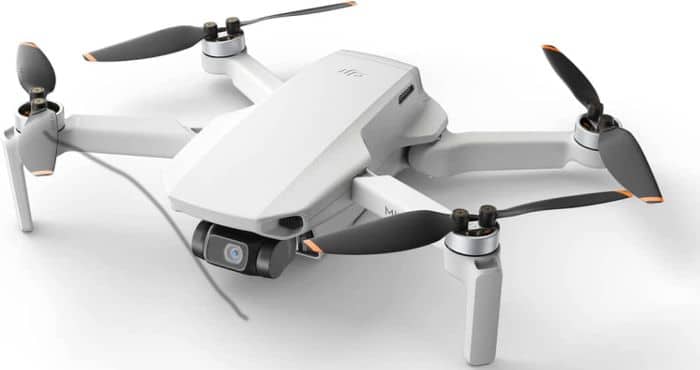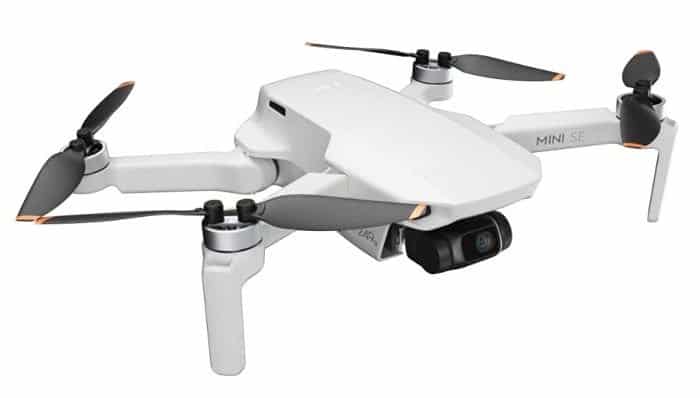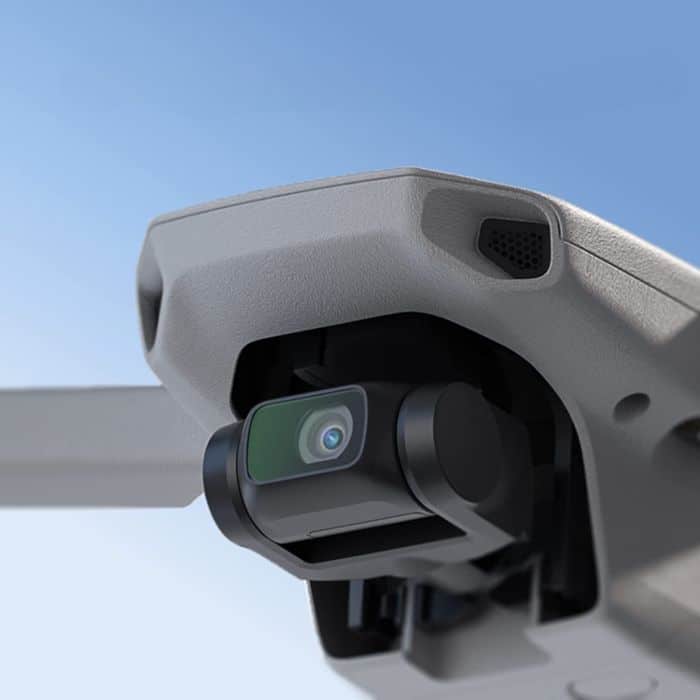DJI Mini SE Short Review

The DJI Mini SE is a lightweight drone weighing less than 250g, so it will not be required to register with the FAA. This miniature drone comes equipped with some impressive features, including an HD camera that can record 2.7k videos and capture 12MP images. The camera is stabilised by a 3-axis gimbal that will minimise distortion, and the drone has a micro SD card slot to store your media files. The drone comes with 5 Quickshots that will allow you to create short, high-quality videos at the push of a button and an automatic return-to-home feature. The maximum flight time is 30 minutes, and the transmission range is around 4km.
Key Features
- 1/2.3-inch sensor with 24mm lens, fixed f/2.8 aperture & 83°FOV
- 12MP images
- Records videos in 2.7k at 30fps 1080p at 60fps
- 40Mbps Video bitrate
- Quickshots video recording mode
- Automatic return to home
- 30 minutes of flight time
- 4km transmission range
- Records HD videos in 2.7K
- 12MP images are crisp
- No image or video distortion thanks to the 3-axis gimbal for stabilisation
- 31 minutes of flight time
- It has a long video transmission range
- The Quickshot feature will allow anyone to record high-quality short videos
- No 4K videos
- The camera cannot capture RAW images
- No obstacle avoidance system
- No follow-me mode
DJI Mini SE Full Review
It’s been a couple of years since the DJI Mini SE was first released, and with newer drones hitting the market every year, it’s natural to wonder if this budget-friendly drone is still worth considering in 2023. Despite being marketed as a budget gateway to the drone market, the Mini SE impressed many drone enthusiasts with its range of features and impressive performance, and it’s worth taking a closer look to see how it holds up against newer models. In this updated DJI Mini SE review, we’ll dive into the dromes features, performance, and overall value proposition, to help you determine if it’s still a good investment for your drone needs. So, if you’re considering the DJI Mini SE or just curious about how it stacks up against newer models, read on to find out everything you need to know.
DJI Mini SE – Design and Build Quality
The Mini SE is part of DJI’s entry-level drones in the sub-250g category; this is one of the most popular drone weight categories because, for people who fly for recreational reasons, there is no need to register the drone with the FAA.
When I first laid eyes on the DJI Mini SE, I was immediately impressed by its sleek and modern design. The drone has a compact and lightweight build, making it easy to store and carry around. The body of the drone is made from durable materials that feel sturdy and well-built.

One thing I particularly love about the Mini SE is the attention to detail in its design. The camera is attached to a 3-axis gimbal stabiliser, which is concealed beneath a plastic lens cap that must be removed for flight. The drone is also equipped with vents located at the front, just above the gimbal, and vision sensors positioned at the rear, along with an IR sensor. These features enable the drone to accurately land and perceive the ground, making necessary adjustments to compensate for drift.
Overall, the design and build quality of the DJI Mini SE is impressive and doesn’t feel cheap, despite being one of DJI’s least expensive drones.
DJI Mini SE Controller
The DJI Mini SE comes with a compact controller that has fold-out arms to hold a phone. The phone serves as a monitor, allowing you to see what the drone’s camera sees. The controller has a Micro-USB socket on the left, which serves as a charging port for the 2600mAh battery or phone connection using one of the supplied connectors.
It’s a decent controller, but I do prefer the DJI RC N1 controller or the newer DJI RC Pro controller, the latter of which comes with a large 5.5-inch screen. Unfortunately, the DJI Mini SE is incompatible with either controller, so you are stuck with the one it comes with.
DJI Mini SE Fly More Combo
The DJI Mini SE Fly More Combo is also available, which includes three batteries, a high-quality carry case, prop guards, different cables and a three-battery charging hub. It costs around $100 more but is totally worth the investment because of the two extra batteries and charging hub.
DJI Mini SE – Features
One of the standout aspects of the DJI Mini SE is its impressive set of features and capabilities, making it a great option for both novice and experienced drone enthusiasts. Here’s a closer look at what this drone has to offer:
DJI Fly App
To fully utilise the DJI Mini SE’s features and capabilities, you’ll need to use the DJI Fly app. This app is available for free on both iOS and Android devices and is user-friendly, making it easy for beginners to get started.
It’s a cool app, although not as feature-rich as the DJI GO 4 App, but it is easy to use and navigate. One thing you may or may not be aware of is that the app is longer listed on the Google Play Store; if you have an Android device, you will need to download it from the DJI website.
DJI Mini SE Camera

The DJI Mini SE is equipped with a 12MP camera mounted on a 3-axis gimbal. The camera can capture 2.7K video at 30fps and 1080p video at 60fps.
The camera’s field of view is 83 degrees, which is wide enough to capture a lot of detail in the shot. The aperture of the camera is f/2.8, which is standard for most drones in this price range. The camera’s electronic shutter can be adjusted from 4 seconds to 1/8000, giving you plenty of options for adjusting exposure settings.
The DJI Mini SE is a good choice for those looking for an entry-level drone for photography. Although the camera does not support RAW format, it produces high-quality JPEG images. The colours look natural, and there is no aggressive sharpening. Overall, the camera produces pictures and videos that are good quality with no detectible distortion.
The drone has a 3-axis gimbal that ensures videos and photos are crisp and stable, even in mildly windy conditions. The gimbal also allows you to control the camera’s angle, giving you the flexibility to capture different types of shots.
The camera is one of the main feature people look at, and the DJ Mini SE does not disappoint; although it does not record 4k videos or shoot RAW images, the overall quality is impressive, as can be seen from the footage below.
DJI Mini SE Flight Modes
The DJI Mini SE offers various flight modes to cater to different user preferences and filming requirements. Here’s a brief overview of the flight modes available with the Mini SE:
Position mode (P-mode): In this mode, the drone relies on GPS and vision sensors to provide stable hovering and precise positioning. The maximum speed in P-mode is 17.8 mph, making it suitable for beginners and general-purpose flying.
CineSmooth mode (C-mode): Similar to P-mode, CineSmooth mode also uses GPS and vision sensors for stable hovering and positioning. However, the maximum speed is reduced to 8.9 mph for smoother, more cinematic footage. This mode is ideal for capturing slow and steady shots.
Sport mode (S-mode): This mode offers increased responsiveness and higher maximum speed, reaching up to 29 mph. It is designed for more experienced pilots who want a more thrilling flying experience or need to cover larger distances quickly.
ATTI mode: ATTI (Attitude) mode is activated when the drone loses its GPS signal, or the vision sensors are disabled. In this mode, the drone does not rely on GPS for positioning and becomes more challenging to control, as it only maintains altitude and not position. ATTI mode should be used by experienced pilots, as it requires more advanced flying skills to manage the drone’s movements safely.
If you are a beginner, you should stick with either the Position mode or Cinemasmooth mode, as they are easier to operate. If you want to improve your drone pilot skills, you can try ATTI mode, but only fly in wide open areas and make sure there are no people around.
Intelligent Features
The DJI Mini SE has a couple of intelligent features that make it easier to control and fly. These include Quickshots and an automatic return-to-home function.
The QuickShots mode lets you choose from four pre-programmed flight patterns. These patterns include Dronie, Circle, Helix, and Rocket. When one of these flight patterns is selected, the drone automatically records a short video around 15 seconds long.
This feature is very easy to use, and the videos can be edited within the DJI Fly App and shared on social media.
The other intelligent feature is the automatic return to home (RTH) function, which is available on many GPS drones and minimises the risk of losing or damaging your drone.
The RTH feature is activated automatically whenever the connection between the and controller is lost for more than a few seconds. The RTH feature is also activated when the battery on the drone gets low on charge.
DJI Mini SE Wind Resistance
While the overall flight performance of the DJI Mini SE is good, what many people want to know is how this drone performs in moderate wind conditions.
DJI has given the Mini SE a level 5 wind resistance rating which translates to around 22 mph. According to the Royal Meteorological Society is classed as a fresh breeze where leaves in small trees begin to sway.
Although I never fly in mildly windy conditions, the video below shows that the DJI Mini SE has pretty good wind resistance, better than what DJI claim.
Does the DJI SE Have Follow Me Mode?
While the DJI Mini SE, like the original Mavic Mini and Mini 2, does not offer a built-in follow-me feature within the DJI Fly app, there is an alternative app that provides access to follow-me mode and other popular autonomous modes like point of interest and waypoint.
The Litchi app is a popular choice among DJI drone pilots, serving as a reliable alternative to the DJI Fly app. With Litchi, you can enable follow-me mode, orbit waypoint and panorama on your DJI Mini SE, enhancing your flight experience.
Litchi is compatible with both iOS and Android devices, though it comes with a price. On the Apple App Store, the app costs $22.99, while on the Google Play Store, it is priced at $24.99.
By using the Litchi app, you can unlock additional flight capabilities with your DJI Mini SE, allowing for a more versatile and enjoyable drone flying experience.
The app is feature-rich, and many DJI drone pilots prefer the app over the DJI Fly App; they update it regularly, and the support is good. For more information about the Litchi app, click here.
Final Thoughts
In conclusion, the DJI Mini SE is a very good compact drone that offers the same features as its predecessor but at a much more affordable price point. It stands out as one of the best drones in its price range, providing exceptional value for both beginners and experienced pilots alike. With its combination of performance, ease of use, and portability, the DJI Mini SE is an excellent choice for anyone looking to explore the world of aerial photography and videography. If you’re interested in exploring alternative options, consider checking out our list of the best drones under 250 grams.
FAQs
Is the Mini SE worth it?
If you’re looking for an affordable GPS drone with advanced features, the Mini is a great option to consider! The DJI Mini SE, which is the most budget-friendly drone in DJI’s Mini lineup, offers excellent value for its price point. However, if you’re a complete beginner, it may be more suitable to opt for a more economical drone, such as the Tello.
What is the difference between the Mini and Mini SE?
The primary difference lies in the body design. The Mini SE’s body is more similar to the Mini 2, which results in better performance in windy conditions. Other features, such as the camera, flight time, transmission range, and controller, remain the same.
How far can the DJI Mini SE fly?
The DJI Mini SE has a maximum transmission range of around 4 km. However, it’s essential to keep the drone within your visual line of sight unless you have permission to operate drones with a BVLOS certificate.
Does the Mini SE have obstacle avoidance?
No, the Mini SE does not have an obstacle avoidance system. If you’re concerned about crashing, consider purchasing propeller guards to minimise damage in case of an accident. The only drone with obstacle avoidance in the DJI Mini range is the DJI Mini 3 Pro.
Do you need to register the DJI Mini SE?
Registration requirements vary depending on your location and intended use. In the USA, you don’t need to register the drone for recreational purposes, but you must take the FAA TRUST exam. For commercial use, obtain an FAA Part 107 certificate and register the drone.
In the UK, you need to obtain a Flyer ID by taking an online test and an Operator ID for your registration number. For more information, visit the CAA website.
For other countries, consult your local aviation authority for drone operation requirements.

